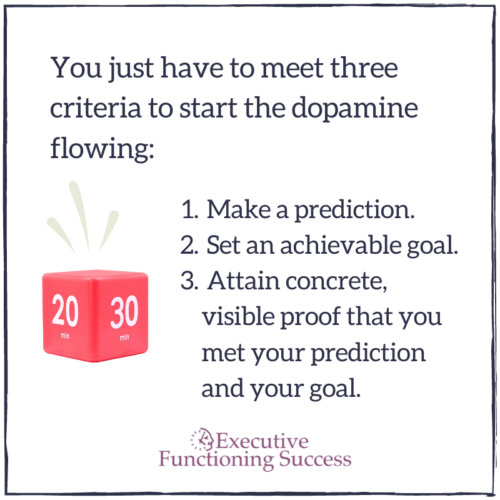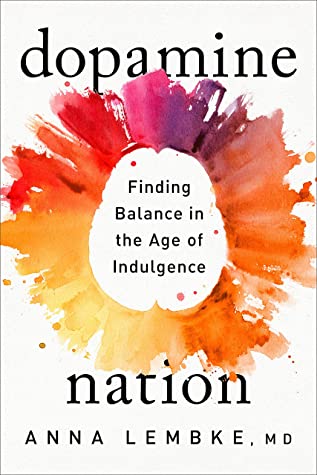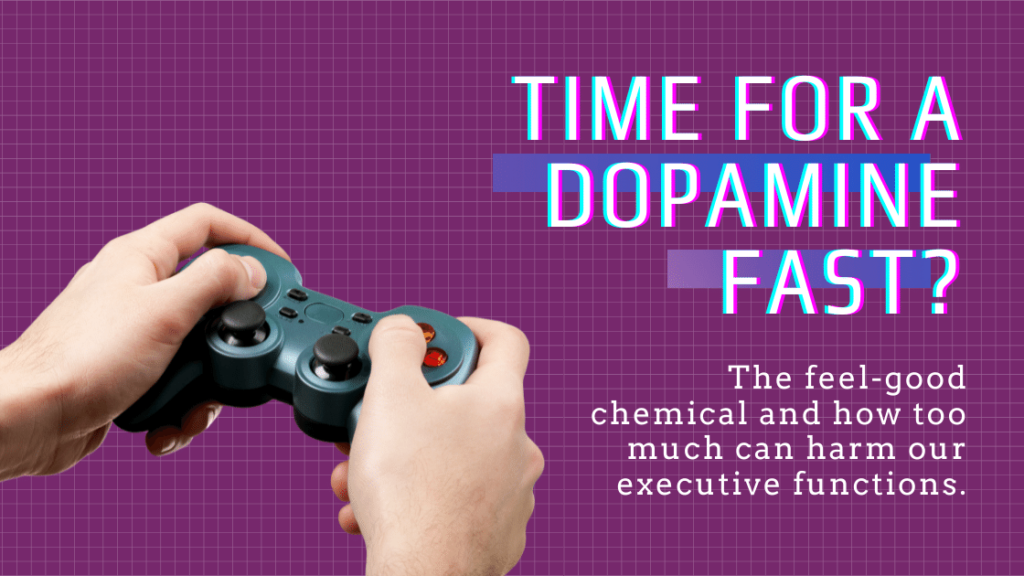I have been thinking lately about the wisdom of my mother’s frequently used saying: Too much of good thing can be bad for you. This is especially true when it comes to our executive functions.
I’m particularly referring to the key neurotransmitter, dopamine. Dopamine is a brain chemical connected to learning and motivation; a “feel good” chemical of the brain. In my Seeing My Time course, I explain how raising the level of dopamine using a cube timer can help us to get started on tasks that we don’t want to do.
This essentially works by following the model of video game design which activates the release of dopamine from the nucleus accumbens. It’s pretty simple really. You just have to meet three criteria to start the dopamine flowing:
- Make a prediction.
- Set an achievable goal.
- Attain concrete, visible proof that you met your prediction and your goal.
When those three things happen, BINGO! The dopamine starts flowing. We now feel good about our accomplishments and become motivated to keep working on that previously dreaded task.
So…how can that dopamine be bad?
 Well, that video game model came into being when game designers began studying the research on gambling addiction. Once they understood the science behind this neurological process, they were able to harness it to – you guessed it – sell more video games.
Well, that video game model came into being when game designers began studying the research on gambling addiction. Once they understood the science behind this neurological process, they were able to harness it to – you guessed it – sell more video games.
Here’s the issue. Incessantly pumping dopamine into the brain upsets a delicate chemical balance that has evolved over the millennia. Our brain is wired to seek an internal “normal” chemical balance between pleasure and pain, which is processed in the same area of the brain.
When we get too much pleasure (the dopamine rewards), guess what? Our brain regulates that excessive dopamine by tipping over to the side of pain, reducing the number of dopamine receptors. This explains the letdown feeling when a pleasurable activity ends. It is literally a chemical response that Dr. Anna Lembke, a psychiatrist and professor at Stanford University, likens to the feelings of a hangover. She says that if we wait long enough, the brain will rebalance and the negative feeling will go away. However, people often return to that pleasurable activity to counteract the pain.
Eventually, this drive for pleasure messes with the set-point for balance, and the brain pushes us to seek more pleasure, but at the cost of increased pain that manifests as the symptoms of withdrawal from addictive substances: anxiety, irritability, insomnia, dysphoria, (dissatisfaction with life sliding into hopelessness) and a consuming craving for the source of the pleasure.
Finding Dopamine Balance
 Dr. Lembke has published a new book: Dopamine Nation: Finding Balance in the Age of Indulgence. She reports that in her practice she has seen a significant rise in depression. Interestingly this is a global phenomenon with a worldwide increase of 50% for new cases of depression between 1990 and 2017.
Dr. Lembke has published a new book: Dopamine Nation: Finding Balance in the Age of Indulgence. She reports that in her practice she has seen a significant rise in depression. Interestingly this is a global phenomenon with a worldwide increase of 50% for new cases of depression between 1990 and 2017.
Also interesting is that this rise is occurring in high-income areas, especially in North America. Historically she would start treating new depressed patients with an antidepressant. Now she often has patients start with a “dopamine fast” instead.
How a Dopamine Fast Works
What is a dopamine fast? For one of her patients, it meant abstaining from all screens, including video games for one month. This young man was so desperate that he did it.
This didn’t mean that he was giving up gaming forever. It just gave his brain the time to get back to a healthy set point of equilibrium between the pleasure and pain centers of his brain. The young man was surprised at how great he felt after the dopamine fast. His anxiety and depression dropped. This fast also gave him time to set up a plan to keep from overly activating dopamine in his brain so he could stay balanced. Here’s how he did it:
- He limited his video game playing to no more than two days a week, for just two hours a day. This gave his brain time to chemically come back to balance.
- He avoided games that were so potent that he couldn’t stop playing.
- He used one laptop for school work and a different one for playing games.
- He avoided games with strangers so that he was only playing with friends which strengthened his friendships.

What’s Your Digital Drug?
While many of us may not be addictively attached to video games, many of us have our own “digital drug” of choice, which is how Dr. Lembke refers to excessive cell phone use. Our brains are very susceptible to seeking out more and more pleasure on digital sites like social media and online shopping.
Reading about Dr. Lembke’s work set the wheels of my brain in motion. The occasional use of my cube timer isn’t guilty of pumping excessive dopamine into my brain. However, what about my lunchtime binges on YouTube watching cooking videos? It seems like it is getting harder to limit my time to 15 minutes. Time gets away from me as I am having “fun” watching some pretty random things I will never attempt in the kitchen. I’m a little grumpy when I have to stop and start work again.
Do you have a digital drug of choice? How do you handle it?
All things in moderation,
Marydee

